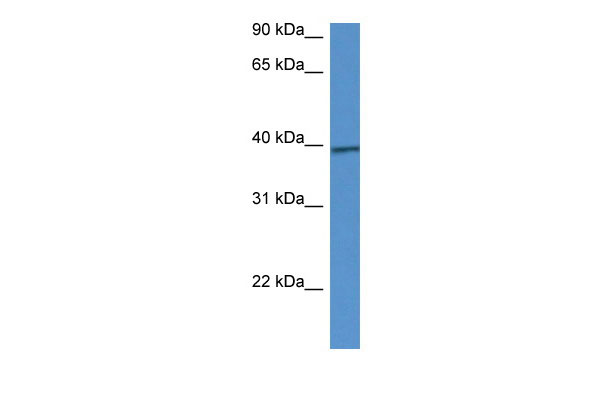EG546729 antibody - C-terminal region
Rabbit Polyclonal Antibody
- 产品详情
- 实验流程
Application
| WB |
|---|---|
| Primary Accession | D3Z291 |
| Other Accession | NM_001081271, NP_001074740 |
| Reactivity | Human, Mouse, Rat, Rabbit, Pig, Dog, Horse, Bovine |
| Predicted | Human, Mouse, Rat, Rabbit, Pig, Dog, Horse, Bovine |
| Host | Rabbit |
| Clonality | Polyclonal |
| Calculated MW | 38827 Da |
| Gene ID | 546729 |
|---|---|
| Alias Symbol | EG546729 |
| Other Names | Calcium homeostasis modulator protein 1, Calhm1 |
| Format | Liquid. Purified antibody supplied in 1x PBS buffer with 0.09% (w/v) sodium azide and 2% sucrose. |
| Reconstitution & Storage | Add 50 ul of distilled water. Final anti-EG546729 antibody concentration is 1 mg/ml in PBS buffer with 2% sucrose. For longer periods of storage, store at 20°C. Avoid repeat freeze-thaw cycles. |
| Precautions | EG546729 antibody - C-terminal region is for research use only and not for use in diagnostic or therapeutic procedures. |
| Name | Calhm1 {ECO:0000303|PubMed:22711817, ECO:0000312|MGI:MGI:3643383} |
|---|---|
| Function | Pore-forming subunit of gustatory voltage-gated ion channels required for sensory perception of sweet, bitter and umami tastes (PubMed:23467090). With CALHM3 forms a fast-activating voltage-gated ATP-release channel in type II taste bud cells, ATP acting as a neurotransmitter to activate afferent neural gustatory pathways (PubMed:23467090, PubMed:29681531). Acts both as a voltage-gated and calcium-activated ion channel: mediates neuronal excitability in response to membrane depolarization and low extracellular Ca(2+) concentration. Has poor ion selectivity and forms a wide pore (around 14 Angstroms) that mediates permeation of small ions including Ca(2+), Na(+), K(+) and Cl(-), as well as larger ions such as ATP(4-) (PubMed:22711817, PubMed:28734079, PubMed:29681531, PubMed:33788965). Mediates Ca(2+) influx and downstream activation of the ERK1 and ERK2 cascade in neurons (By similarity). Triggers endoplasmic reticulum stress by reducing the calcium content of the endoplasmic reticulum (By similarity). May indirectly control amyloid precursor protein (APP) proteolysis and aggregated amyloid-beta (Abeta) peptides levels in a Ca(2+) dependent manner (By similarity). |
| Cellular Location | Cell membrane {ECO:0000250|UniProtKB:Q8IU99}; Multi-pass membrane protein {ECO:0000250|UniProtKB:Q8IU99}. Endoplasmic reticulum membrane {ECO:0000250|UniProtKB:Q8IU99}; Multi-pass membrane protein {ECO:0000250|UniProtKB:Q8IU99}. Basolateral cell membrane; Multi-pass membrane protein Note=Localizes to the basolateral membrane of epithelial cells including taste cells (PubMed:30804437). Colocalizes with HSPA5 at the endoplasmic reticulum (By similarity). {ECO:0000250|UniProtKB:Q8IU99, ECO:0000269|PubMed:30804437} |
| Tissue Location | Specifically expressed in type II taste bud cells (at protein level). Not expressed in brain |
Research Areas
For Research Use Only. Not For Use In Diagnostic Procedures.
Application Protocols
Provided below are standard protocols that you may find useful for product applications.
终于等到您。ABCEPTA(百远生物)抗体产品。
点击下方“我要评价 ”按钮提交您的反馈信息,您的反馈和评价是我们最宝贵的财富之一,
我们将在1-3个工作日内处理您的反馈信息。
如有疑问,联系:0512-88856768 tech-china@abcepta.com.























 癌症的基本特征包括细胞增殖、血管生成、迁移、凋亡逃避机制和细胞永生等。找到癌症发生过程中这些通路的关键标记物和对应的抗体用于检测至关重要。
癌症的基本特征包括细胞增殖、血管生成、迁移、凋亡逃避机制和细胞永生等。找到癌症发生过程中这些通路的关键标记物和对应的抗体用于检测至关重要。 为您推荐一个泛素化位点预测神器——泛素化分析工具,可以为您的蛋白的泛素化位点作出预测和评分。
为您推荐一个泛素化位点预测神器——泛素化分析工具,可以为您的蛋白的泛素化位点作出预测和评分。 细胞自噬受体图形绘图工具为你的蛋白的细胞受体结合位点作出预测和评分,识别结合到自噬通路中的蛋白是非常重要的,便于让我们理解自噬在正常生理、病理过程中的作用,如发育、细胞分化、神经退化性疾病、压力条件下、感染和癌症。
细胞自噬受体图形绘图工具为你的蛋白的细胞受体结合位点作出预测和评分,识别结合到自噬通路中的蛋白是非常重要的,便于让我们理解自噬在正常生理、病理过程中的作用,如发育、细胞分化、神经退化性疾病、压力条件下、感染和癌症。






